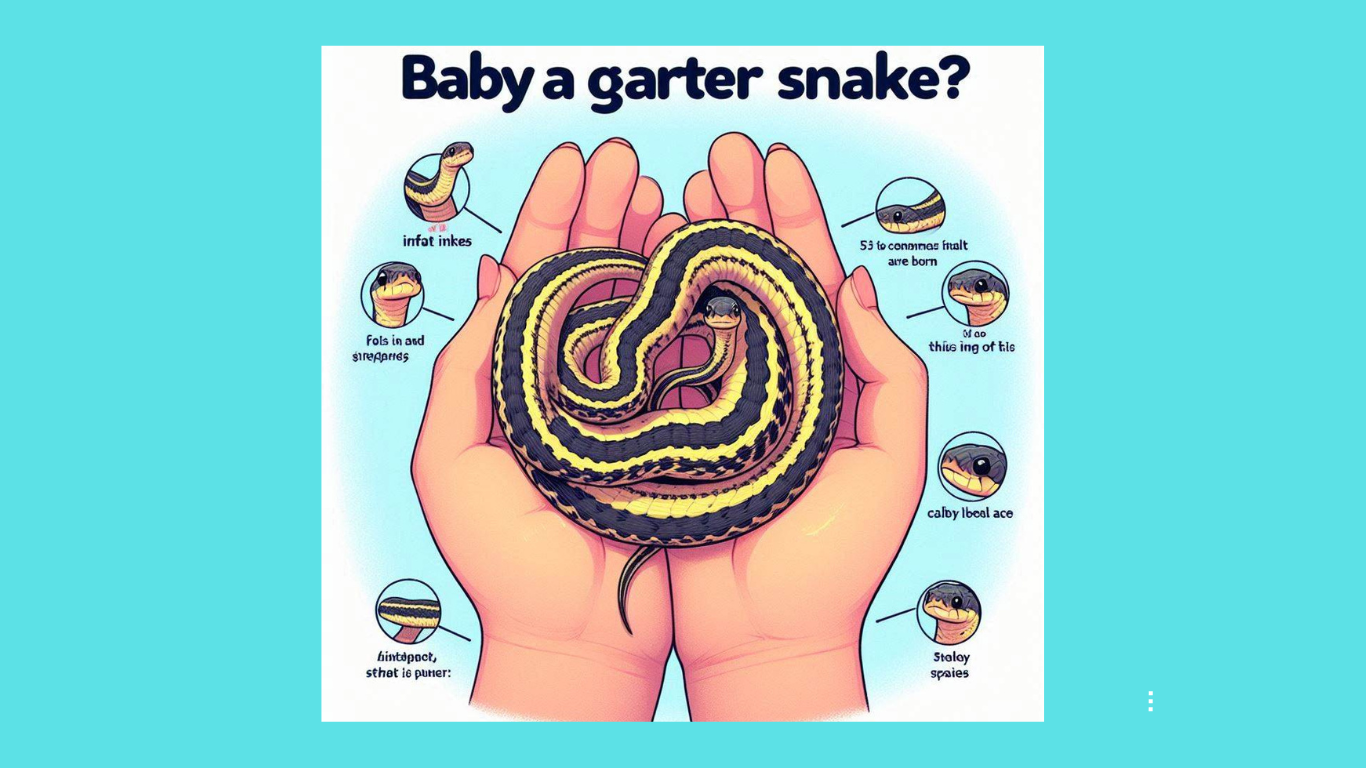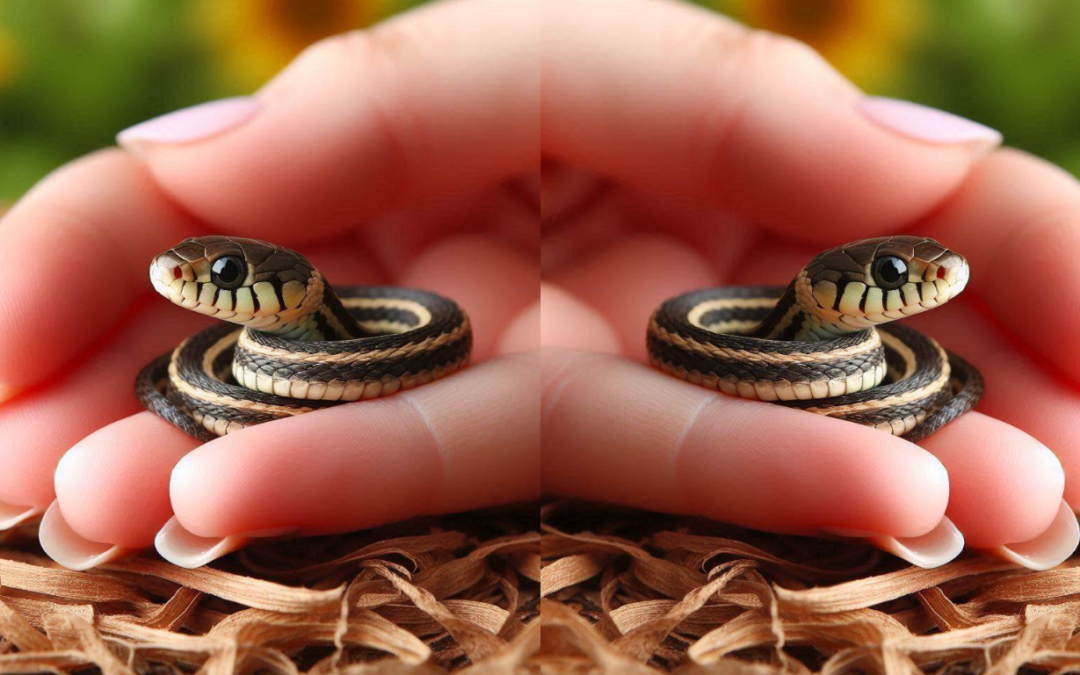Introduction
The baby garter snake is an interesting reptile that fascinates nature lovers and passersby. Baby garter snakes are one of the most frequently seen young reptiles in North America. Even though they are small at birth, these reptiles are highly adaptable and are found quite commonly in many areas. This article gives detailed information regarding the baby garter snake, including its physical appearance, size, color, regional differences, care, bite, and diet. Baby garter snake is a part of the environment and needs to be released when the time is right.
What Does a Baby Garter Snake Look Like?

Infant garter snakes look much like their fully grown adult counterparts, but smaller. They are, on average, 5 to 9 inches (13 to 23 centimeters) in length when they are born. Their elongated bodies have three horizontal stripes along the length of their backs and sides. These stripes are often yellow but may differ, depending on the snake’s geographical location and particular subspecies.
Birth Size and Average Length
Baby garter snakes are about 5 to 9 inches (12.5 to 23 cm) long at birth. As they grow, they become much larger, with lengths varying by species and geographic area. Common garter snakes, for example, grow to 18 to 54 inches (46 to 137 centimeters) in length.
Color and Patterns
Baby garter snakes come in a range of colors and patterns, usually the same as adults but occasionally with brighter colors. Typically, they have a black or brownish-green background color with three clear longitudinal stripes down their bodies. These are usually yellow but sometimes green, blue, or white. In others, the stripes can be missing, and a checkered appearance substitutes for the usual striping. The belly is typically lighter, frequently white or light yellow, to complement the overall coloration.
Regional Variations
The appearance of baby garter snakes can differ significantly from one region to another as a result of environmental factors and genetic variation.
- Florida: Florida baby garter snakes can have a bluish bottom color, thus making them stand out from those in other regions.
- Ohio: Ohio has the common garter snake and the eastern garter snake. Although full reports of juveniles’ coloration in Ohio are not often made, they often match the common pattern of black bodies and yellow stripes.
- Oklahoma: Oklahoma supports some species of garter snakes, some of which are the plains garter snake and the common garter snake. Juveniles here could have the normal dark body and yellow stripes, but color variations in the form of different species’ presence.
- Alabama: In Alabama, the most common is the eastern garter snake. Infant garter snakes here usually come in the typical dark body with yellow stripes, typical of the overall appearance of the species.
- South Carolina: South Carolina is mostly populated by the eastern garter snake. Juveniles here typically present the normal coloration and pattern of dark bodies with yellow longitudinal stripes.
Key Identifying Features
When it comes to recognizing baby garter snakes, some important features are in order:
- Longitudinal Stripes: Three longitudinal stripes along the body length are characteristic of garter snakes. They are yellow but may be in other hues as well.
- Body Color: The body color can be black and brown to green, depending on geographical influence.
- Belly Color: A paler-colored belly, typically white or pale yellow, is lighter than the body coloration.
- Head Shape: There is a broad head about the neck, with flat, dark-colored skin.
- Body Shape: Long and narrow with a well-defined head that is wider than the neck.
- Scales: Keeled scales (scales with a raised ridge along the center) impart a scaly texture to the snake.
- Colouration: Dark ground colour with three longitudinal bands that can be yellow, green, brown, or blue.
Understanding these traits will help in properly identifying baby garter snakes and appreciating the subtle differences depending on their locations.
What Is the Diet of a Baby Garter Snake? Diet for Baby Garter Snakes

As predators, baby garter snakes require small, readily swallowable prey. They consume anything they can catch in the wild, such as:
- Tiny earthworms that resemble red wigglers
- Insects with soft bodies, such as caterpillars and crickets
- Small amphibians, such as young frogs or tadpoles
- Little fish, like minnows or guppies
- Leeches and slugs
A newborn garter snake kept in captivity should be fed soft-bodied insects (such as crickets or waxworms), small earthworms (such as nightcrawlers chopped into bits), and occasionally feeder guppies. They should not be fed anything too big or difficult for their size. Give them tiny meals every two to three days. Make sure the food is always free of pesticides and clean.
Baby Copperhead versus Baby Garter Snake
| Feature | Baby Garter Snake | Baby Copperhead |
|---|---|---|
| Coloration | Brown, black, or green with light yellow stripes | Light tan to gray with dark |
| Pattern | Checkered or striped body | Bold, saddle-like crossbands |
| Tail Tip | Same color as the body | Bright yellow/green tail tip (used for luring) |
| Head Shape | Narrow, oval head (same width as neck) | Triangular head (wider than neck) |
| Pupil Shape | Round pupils | Vertical, slit-like pupils |
| Behavior | Non-aggressive, rarely bites | Can strike if provoked |
Before approaching, always make sure. A common error is to confuse a harmless newborn garter snake with a poisonous copperhead.
Baby Garter Snake Bite: What to Expect
Baby garter snakes are not aggressive and rarely bite unless they feel threatened. Even then, their bite doesn’t harm. A baby garter snake’s bite usually feels like a faint scratch or tiny prick. The majority of patients have little to no bleeding and very mild redness or discomfort.
They have extremely few teeth and no fangs. Just wash the bite location with soap and water to prevent infection. You don’t need to consult a doctor unless you have an allergic reaction, which is quite rare.
Baby Garter Snake Poisonous?
Garter snakes are not toxic when they are young. It’s a frequent misconception. Their saliva does contain a small amount of venom, which they employ to aid in subduing small prey like frogs or worms. But people are not harmed by its venom. People won’t be harmed by the venom even if they are bitten because it lacks a delivery mechanism like fangs. At worst, you may have mild swelling or a tiny itching sensation. There are no effects at all for the majority of persons. It is safe to watch and gently handle garter snakes, even infants, if necessary.
How to Take Care of a Baby Garter Snake (In Case You Come Across One)
If you find a baby garter snake, it is always advisable that you do not handle it. Baby garter snakes are wild and prefer to be in their habitat. If you find the snake injured or being threatened, then you can gently put it inside a small container with holes in it and also soft paper towels. Put it in a warm, quiet place with no pets or humans. Never attempt to feed it unless consulted by a wildlife professional. Always call upon a local wildlife facility. Baby garter snakes are part of the natural world and should be returned when safe.
Interesting Facts About Baby Garter Snakes
- Born Alive: In contrast to most snakes, baby garter snakes are born alive and not egg-laying.
- Small Size: They are only 5 to 9 inches long when they are born.
- Hungry From Birth: They begin hunting small animals such as worms and insects immediately after birth.
- Quick Growers: They develop rapidly, shedding their skin periodically in their first year of life.
- Several Predators: They are hunted by birds, snakes, and mammals.
- Alone from Birth: They are not cared for by their mother and have to live independently.
- Enjoy Hiding: They hide themselves from danger beneath leaves, logs, and rocks.
- Large Families: One mother gives birth to 10–40 babies in one litter.
- Skilled at Escape: Their quick movement prevents them from being caught by predators.
- Striped to Survive: They are striped, by nature, and thereby camouflage themselves in the grassland.
Conclusion: Loving the Young Garter Snake
Garter snake babies are little, fast, and curious. They are boldly striped and consume tiny animals such as worms and insects. Despite others being afraid of snakes, garter snakes are harmless and not poisonous. Even their bites are flawless and amount to nothing but a scratch. They are good for nature in that they keep a check on insects and pests. If you can spot one, have the experience of watching it at a distance. Grant it some space and let it live its day. Baby garter snakes are a unique component of our nature and have to be kept in the wild and unconfined.
FAQs On Baby Garter Snake
- Q: Is a baby garter snake venomous?
- A: No, it is harmless, and it is safe to keep it around.
- Q: What will the baby garter snake eat?
- A: It will eat small worms, bugs, tadpoles, and small fish.
- Q: Can one have a baby garter snake as a pet?
- A: Yes, one can, but it is best not to keep wild ones; leave them alone in the wild if they are injured.
- Q: How big is a baby garter snake?
- A: It is 5 to 9 inches in length when born.
- Q: Does a baby garter snake bite?
- A: It can, but its bite is weak and harmless.


As we honor the **Snakes—**—reflects the profound bonds.
Snakes, though unconventional as pets, captivate with their elegance and mystique.
Each pet, regardless of species, leaves an indelible mark on our lives and the joy they brought into our homes.